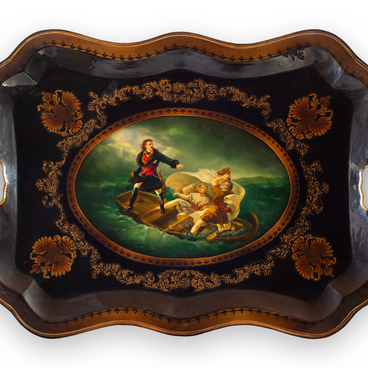The iron tray with the painting “Scene at the Fountain” was likely produced in the 1870s. This item of decorative and applied art was handcrafted using the forging technique. On the surface of the tray, the artist depicted a genre scene. A group of people — six women and one man — are sitting near a fountain. Interestingly, their clothes belong to different historical periods, including antiquity, the Middle Ages, and the modern era.
The painting is characterized by features of lubok art, Russian popular prints. It is distinguished by bright colors and simplified figures. The scene is enclosed in a golden frame, with traditional Nizhny Tagil flowers used to decorate the background around the frame.
In the late 19th century, handicraft production in the Russian Empire faced a crisis that also affected the Nizhny Tagil tray painting art. The emancipation of the serfs contributed to an increase in prices for many basic and additional materials. At the same time, wholesalers insisted on buying finished products at lower prices. Tray painting artists had to adapt to this changing environment. The mold press began to replace the manual work of blacksmiths.
Amid the growing competition, the cost of production had to be reduced, and artists attempted to produce their works faster. At this time, the quick single-layer painting technique became popular. An artist would pick up colored paint and white paint with the tip of the brush at the same time, creating a flower or a leaf in just two or three brushstrokes. This led to a simplification of details and the use of stylized forms.
At the end of the 19th century, the tray industry in the Nizhny Tagil Mining District was declining. This was reflected in both the techniques and quality of the painting and in the decoration of the trays. Many decoration techniques, especially those that required a lot of time and effort, came out of use. During this time, narrative paintings almost disappeared from trays, while simplified floral painting was combined with lubok-style genre scenes. An example of this is the tray from the museum collection titled “Scene at the Fountain”.


